Marine Heatwaves and Cold Spells in Global Coral Reef Regions (1982–2070): Characteristics, Drivers, and Impacts
Abstract
1. Introduction
2. Materials and Methods
2.1. Data Sources
2.1.1. OISST V2.1 Dataset
2.1.2. CMIP6 Dataset
2.1.3. Climate Dataset
2.1.4. The Hard Coral Coverage Dataset
2.2. Definition of MHWs and MCSs
2.3. Analysis Methods
3. Results
3.1. Global Patterns in Mean MHW and MCS Metrics in Coral Reef Zones from 1982 to 2022
3.2. Global Trends in Mean MHW and MCS Metrics in Coral Reef Zones from 1982 to 2022
3.3. Global Trends in Mean MHW and MCS Metrics in Coral Reef Zones from 2023 to 2070
3.4. The Underlying Factors Shaping the Spatial Heterogeneity of MHWs
3.5. Relationship Between MHWs/MCSs and Coral Coverage
4. Discussion
4.1. Higher-Latitude Coral Reefs Are Experiencing More Severe MHWs than Equatorial Regions
4.2. Upper-Ocean Warming Is One of the Most Important Drivers of the Trends in MHWs and MCSs
4.3. MHWs Are Projected to Continue Increasing in the Future
4.4. Relationship Between MHWs/MCSs and Coral Coverage
4.5. Implications
4.6. Limitations and Prospects
5. Conclusions
- (1)
- Over the last four decades, MHWs have not only been increasing in average intensity but also becoming more extreme, while MCSs have declined. The Red Sea, the Persian Gulf, the Hawaiian Islands, the Galapagos Islands, the South Pacific Islands, coastal Australia, and southwestern Sumatra experience high numbers of total days of MHWs, reaching up to 32 days, and MCSs for up to 31 days. The average total days of MHWs are increasing at a rate of up to 28 days/decade.
- (2)
- Higher-latitude coral reefs face more severe MHWs than their equatorial counterparts, with up to 1.24 times more MHW days, highlighting the need to prioritize the protection of coral refuges in these vulnerable regions.
- (3)
- The coefficient of variation (CV) of annual temperature, the annual ocean heat content, and the monthly temperature were important factors driving MHW intensity. We emphasize the critical role of climate variability (CV) over mean climate as a major driver of MHW and further highlight that future MHW predictions should focus more on the CV of forecasting indicators rather than just the climate means to provide new insights for future projections.
- (4)
- From 2023 to 2070, the SST in coral reef zones is projected to rise by 0.2–0.3 °C per decade. We highlight that MHWs are expected to occur nearly year-round under scenario SSP5–8.5, while MCSs are anticipated to decline sharply. The MHW-to-MCS area ratio is forecasted to surge after 2040, reaching approximately 100 times under SSP2–4.5 and 196 times under SSP5–8.5 by 2070, particularly in the Marshall Islands and the Caribbean Sea.
- (5)
- Coral coverage shows a strong negative correlation with MHW intensity (r = −0.54, p < 0.01) and a significant positive correlation with MCSs (r = 0.6, p < 0.01). Coral coverage in the Pacific region demonstrates the highest sensitivity to MHWs. Globally, it shows a recovery lag and post-mortality processes following MHWs.
Author Contributions
Funding
Data Availability Statement
Acknowledgments
Conflicts of Interest
Appendix A


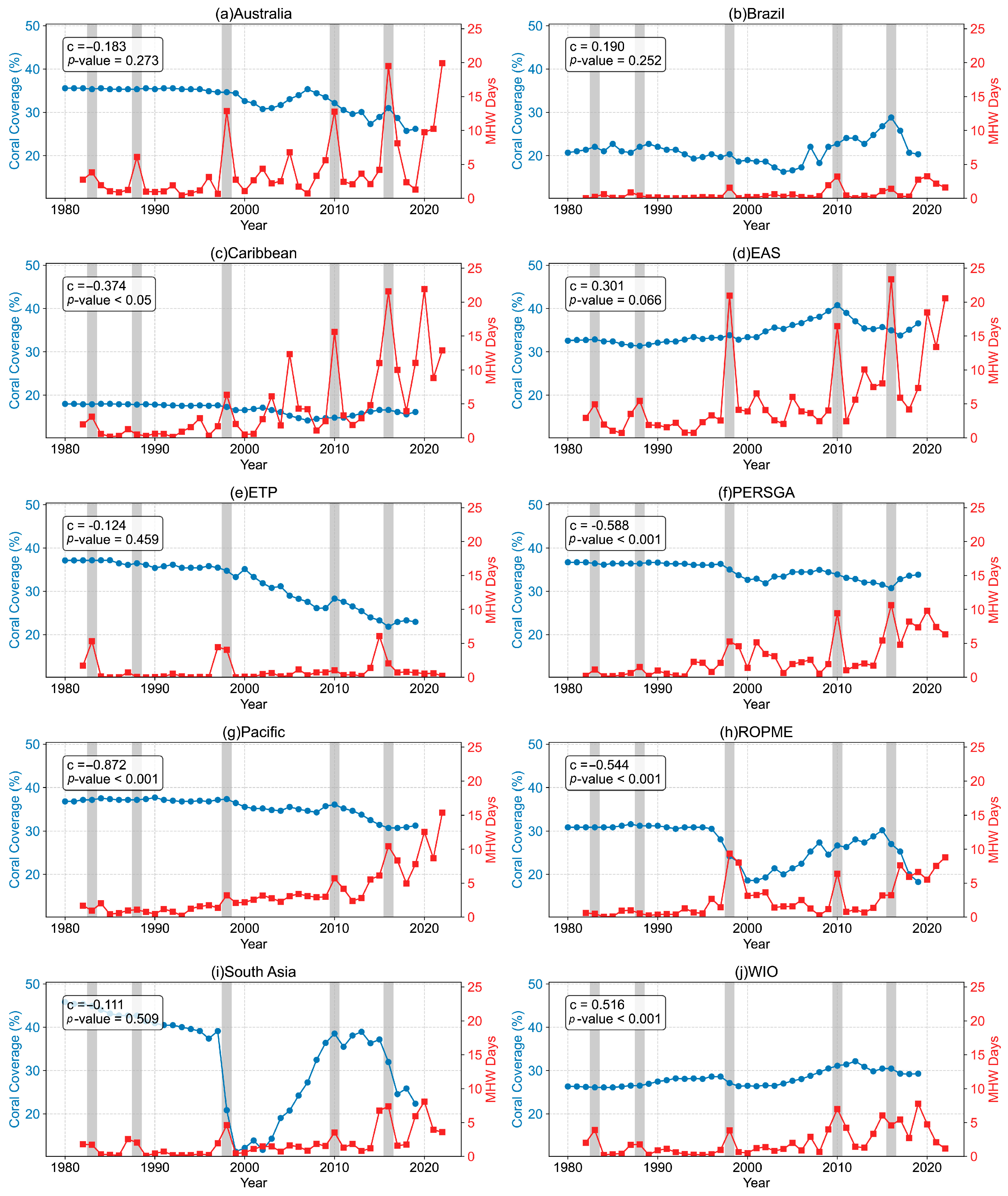
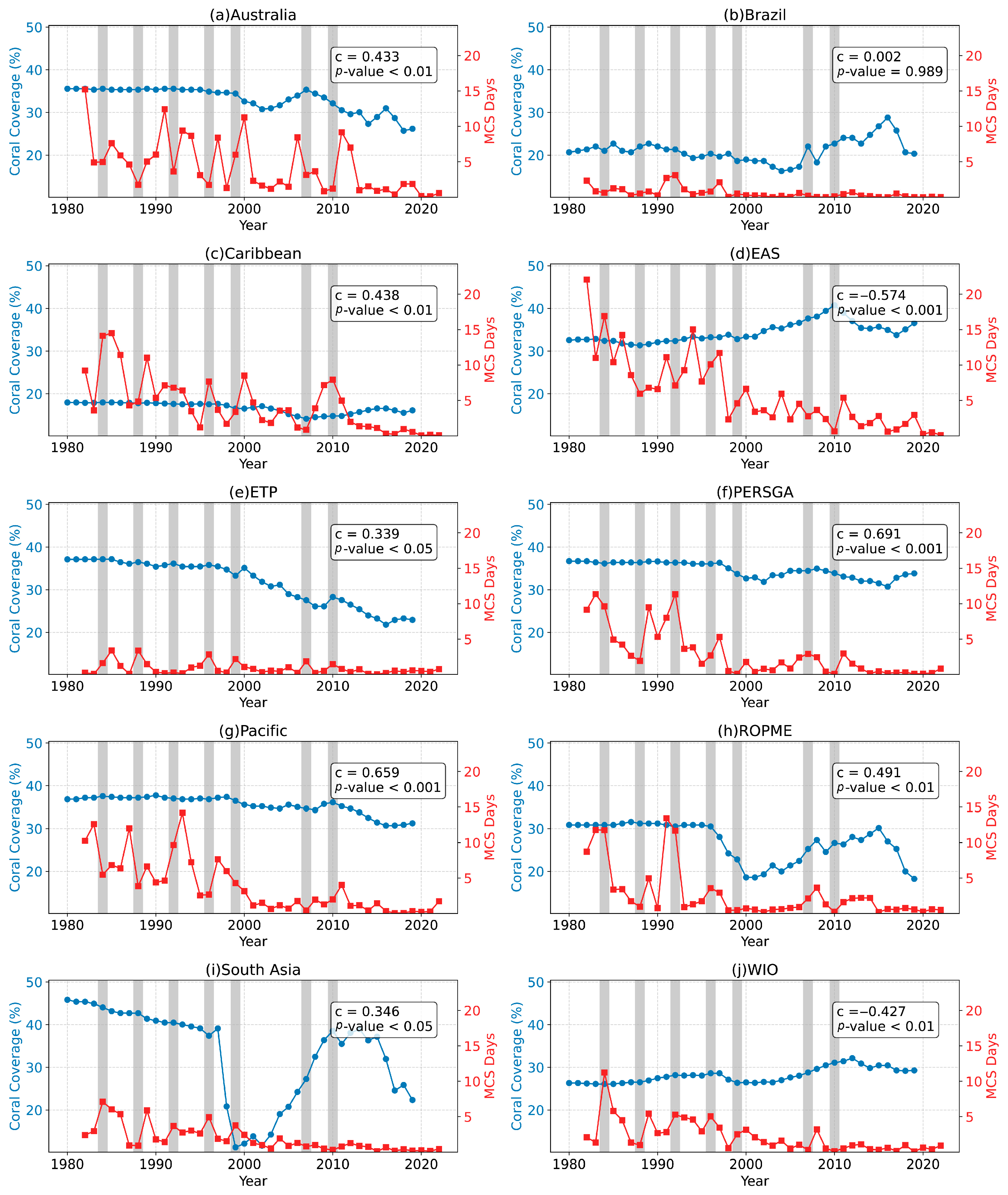
| Variable | Description | Unit | Reference |
|---|---|---|---|
| Dependent variable. | |||
| The total days of MHWs | The sum of all days of MHWs per year, which can directly reflect the severity of MHWs. | days | / |
| Independent variables (features). | |||
| Air temperature at 2 m (t2m) | Directly influences the surface ocean temperature, which is a key factor in the development of MHWs. | °C | [84] |
| Wind speed at 10 m (si10) | Influences ocean currents and mixing, affecting heat exchange between the ocean’s surface and deeper layers. It impacts the distribution of heat in the ocean. | m/s | [58] |
| Ocean heat content (OHC) | Measures heat stored in the upper layers of the ocean. Higher OHC increases the likelihood of MHWs by providing more heat for surface transfer. | J/m2 | [85] |
| Geopotential height at 200 hPa (z_500) | A key indicator of atmospheric circulation patterns that influence MHWs. High-pressure systems are associated with prolonged periods of warm temperatures. | m | [15] |
| Total cloud cover (tcc) | Affects the amount of solar radiation reaching the ocean’s surface. Less cloud cover allows for more heat penetration, contributing to MHWs. | % | [86] |
| Net radiation (Q) | Governs the heat flux at the ocean’s surface, impacting ocean temperature changes. Positive net radiation increases ocean heating and can lead to MHWs. | W/m2 | [1] |
| Random Forest | XGBoost | CatBoost | LightGBM |
|---|---|---|---|
| n_estimators: 500 | objective: reg:squarederror | iterations: 500 | n_estimators: 200 |
| max_depth: 6 | max_depth: 6 | learning_rate: 0.05 | learning_rate: 0.1 |
| min_samples_split: 5 | eta: 0.05 | depth: 6 | num_leaves: 123 |
| min_samples_leaf: 2 | subsample: 0.8 | l2_leaf_reg: 3 | objective: regression |
| random_state: 42 | colsample_bytree: 0.8 | random_seed: 42 | |
| gamma: 0.1 | early_stopping_rounds: 50 |
| Total Days | 30° N–15° N | 15° N–0° | 0° N–15° S | 15° S–30° S |
|---|---|---|---|---|
| trend | 1.309 | 1.051 | 1.135 | 1.241 |
| p-value | 0.000 | 0.000 | 0.000 | 0.000 |
| Average Duration | ||||
| trend | 0.196 | 0.148 | 0.193 | 0.213 |
| p-value | 0.000 | 0.000 | 0.000 | 0.000 |
| Frequency | ||||
| trend | 0.080 | 0.069 | 0.056 | 0.057 |
| p-value | 0.000 | 0.000 | 0.000 | 0.000 |
| Max Intensity | ||||
| trend | 0.006 | −0.002 | −0.002 | 0.006 |
| p-value | 0.000 | 0.444 | 0.347 | 0.002 |
| Total Days | 30° N–15° N | 15° N–0° | 0° N–15° S | 15° S–30° S |
|---|---|---|---|---|
| trend | −0.929 | −0.951 | −1.038 | −1.005 |
| p-value | 0.000 | 0.000 | 0.000 | 0.000 |
| Average Duration | ||||
| trend | −0.031 | −0.034 | −0.012 | −0.043 |
| p-value | 0.280 | 0.022 | 0.579 | 0.175 |
| Frequency | ||||
| trend | −0.081 | −0.096 | −0.102 | −0.077 |
| p-value | 0.000 | 0.000 | 0.000 | 0.000 |
| Max Intensity | ||||
| trend | −0.009 | −0.007 | −0.006 | −0.004 |
| p-value | 0.000 | 0.000 | 0.000 | 0.000 |
References
- Hobday, A.J.; Alexander, L.V.; Perkins, S.E.; Smale, D.A.; Straub, S.C.; Oliver, E.C.; Benthuysen, J.A.; Burrows, M.T.; Donat, M.G.; Feng, M.; et al. A Hierarchical Approach to Defining Marine Heatwaves. Prog. Oceanogr. 2016, 141, 227–238. [Google Scholar] [CrossRef]
- Hoegh-Guldberg, O.; Mumby, P.J.; Hooten, A.J.; Steneck, R.S.; Greenfield, P.; Gomez, E.; Harvell, C.D.; Sale, P.F.; Edwards, A.J.; Caldeira, K.; et al. Coral Reefs under Rapid Climate Change and Ocean Acidification. Science 2007, 318, 1737–1742. [Google Scholar] [CrossRef]
- Pan, Y.; Sun, W.; Bao, S.; Xie, M.; Jiang, L.; Ji, J.; Yu, Y.; Dong, C. Global Variability and Future Projections of Marine Heatwave Onset and Decline Rates. Remote Sens. 2025, 17, 1362. [Google Scholar] [CrossRef]
- Hughes, T.P.; Kerry, J.T.; Álvarez-Noriega, M.; Álvarez-Romero, J.G.; Anderson, K.D.; Baird, A.H.; Babcock, R.C.; Beger, M.; Bellwood, D.R.; Berkelmans, R.; et al. Global Warming and Recurrent Mass Bleaching of Corals. Nature 2017, 543, 373–377. [Google Scholar] [CrossRef]
- Yao, Y.; Wang, J.; Yin, J.; Zou, X. Marine Heatwaves in China’s Marginal Seas and Adjacent Offshore Waters: Past, Present, and Future. J. Geophys. Res. Oceans 2020, 125, e2019JC015801. [Google Scholar] [CrossRef]
- Yu, X.; Yu, K.; Chen, B.; Liao, Z.; Liang, J.; Yao, Q.; Qin, Z.; Wang, H.; Yu, J. Different Responses of Scleractinian Coral Acropora pruinosa from Weizhou Island during Extreme High Temperature Events. Coral Reefs 2021, 40, 1697–1711. [Google Scholar] [CrossRef]
- Pandolfi, J.M.; Connolly, S.R.; Marshall, D.J.; Cohen, A.L. Projecting Coral Reef Futures under Global Warming and Ocean Acidification. Science 2011, 333, 418–422. [Google Scholar] [CrossRef] [PubMed]
- Gardner, T.A.; Côté, I.M.; Gill, J.A.; Grant, A.; Watkinson, A.R. Long-Term Region-Wide Declines in Caribbean Corals. Science 2003, 301, 958–960. [Google Scholar] [CrossRef] [PubMed]
- Brodie, J.; Waterhouse, J. A Critical Review of Environmental Management of the ‘Not so Great’Barrier Reef. Estuar. Coast. Shelf Sci. 2012, 104, 1–22. [Google Scholar] [CrossRef]
- Birkeland, C. Coral Reefs in the Anthropocene; Springer: Berlin/Heidelberg, Germany, 2015. [Google Scholar]
- Hughes, T.P.; Kerry, J.T.; Baird, A.H.; Connolly, S.R.; Dietzel, A.; Eakin, C.M.; Heron, S.F.; Hoey, A.S.; Hoogenboom, M.O.; Liu, G.; et al. Global Warming Transforms Coral Reef Assemblages. Nature 2018, 556, 492–496. [Google Scholar] [CrossRef] [PubMed]
- Maynard, J.A.; Turner, P.J.; Anthony, K.R.; Baird, A.H.; Berkelmans, R.; Eakin, C.M.; Johnson, J.; Marshall, P.A.; Packer, G.R.; Rea, A.; et al. ReefTemp: An Interactive Monitoring System for Coral Bleaching Using High-Resolution SST and Improved Stress Predictors. Geophys. Res. Lett. 2008, 35. [Google Scholar] [CrossRef]
- Feng, Y.; Bethel, B.J.; Dong, C.; Zhao, H.; Yao, Y.; Yu, Y. Marine Heatwave Events near Weizhou Island, Beibu Gulf in 2020 and Their Possible Relations to Coral Bleaching. Sci. Total Environ. 2022, 823, 153414. [Google Scholar] [CrossRef]
- Van Woesik, R.; Houk, P.; Isechal, A.L.; Idechong, J.W.; Victor, S.; Golbuu, Y. Climate-Change Refugia in the Sheltered Bays of P Alau: Analogs of Future Reefs. Ecol. Evol. 2012, 2, 2474–2484. [Google Scholar] [CrossRef] [PubMed]
- Schlegel, R.W.; Oliver, E.C.; Perkins-Kirkpatrick, S.; Kruger, A.; Smit, A.J. Predominant Atmospheric and Oceanic Patterns during Coastal Marine Heatwaves. Front. Mar. Sci. 2017, 4, 323. [Google Scholar] [CrossRef]
- Oliver, E.C.; Donat, M.G.; Burrows, M.T.; Moore, P.J.; Smale, D.A.; Alexander, L.V.; Benthuysen, J.A.; Feng, M.; Sen Gupta, A.; Hobday, A.J.; et al. Longer and More Frequent Marine Heatwaves over the Past Century. Nat. Commun. 2018, 9, 1324. [Google Scholar] [CrossRef] [PubMed]
- Tan, H.; Cai, R.; Yan, X.; Li, C. Amplification of Winter Sea Surface Temperature Response over East China Seas to Global Warming Acceleration and Slowdown. Int. J. Climatol. 2021, 41, 2082–2099. [Google Scholar] [CrossRef]
- Ren, J.; Wang, C.; Yao, Y. Spatiotemporally Continuous Marine Heatwaves: A Novel Clustering Approach Reveals Increasing Frequency, Duration, Area, Intensity, and Movement Distance. Geophys. Res. Lett. 2025, 52, e2024GL113211. [Google Scholar] [CrossRef]
- Amaya, D.J.; Miller, A.J.; Xie, S.-P.; Kosaka, Y. Physical Drivers of the Summer 2019 North Pacific Marine Heatwave. Nat. Commun. 2020, 11, 1903. [Google Scholar] [CrossRef]
- Sun, W.; Wang, Y.; Yang, Y.; Yang, J.; Ji, J.; Dong, C. Marine Heatwaves/cold spells Associated with Mixed Layer Depth Variation Globally. Geophys. Res. Lett. 2024, 51, e2024GL112325. [Google Scholar] [CrossRef]
- Zhang, W.; Zheng, Z.; Zhang, T.; Chen, T. Strengthened Marine Heatwaves over the Beibu Gulf Coral Reef Regions from 1960 to 2017. Haiyang Xuebao 2020, 42, 45–52. [Google Scholar]
- Qiao, L.; Tang, H.; Huang, G. Drivers and Predictability of Summer Marine Heatwaves in the Northwest Pacific. J. Geophys. Res. Atmospheres 2025, 130, e2024JD042994. [Google Scholar] [CrossRef]
- Holbrook, N.J.; Scannell, H.A.; Sen Gupta, A.; Benthuysen, J.A.; Feng, M.; Oliver, E.C.; Alexander, L.V.; Burrows, M.T.; Donat, M.G.; Hobday, A.J.; et al. A Global Assessment of Marine Heatwaves and Their Drivers. Nat. Commun. 2019, 10, 2624. [Google Scholar] [CrossRef]
- Scannell, H.A.; Pershing, A.J.; Alexander, M.A.; Thomas, A.C.; Mills, K.E. Frequency of Marine Heatwaves in the North Atlantic and North Pacific since 1950. Geophys. Res. Lett. 2016, 43, 2069–2076. [Google Scholar] [CrossRef]
- England, M.H.; Li, Z.; Huguenin, M.F.; Kiss, A.E.; Sen Gupta, A.; Holmes, R.M.; Rahmstorf, S. Drivers of the Extreme North Atlantic Marine Heatwave during 2023. Nature 2025, 642, 636–643. [Google Scholar] [CrossRef]
- Di Lorenzo, E.; Mantua, N. Multi-Year Persistence of the 2014/15 North Pacific Marine Heatwave. Nat. Clim. Change 2016, 6, 1042–1047. [Google Scholar] [CrossRef]
- Li, Z.; Holbrook, N.J.; Zhang, X.; Oliver, E.C.; Cougnon, E.A. Remote Forcing of Tasman Sea Marine Heatwaves. J. Clim. 2020, 33, 5337–5354. [Google Scholar] [CrossRef]
- Zhang, Y.; Du, Y.; Feng, M.; Hu, S. Long-Lasting Marine Heatwaves Instigated by Ocean Planetary Waves in the Tropical Indian Ocean during 2015–2016 and 2019–2020. Geophys. Res. Lett. 2021, 48, e2021GL095350. [Google Scholar] [CrossRef]
- Schlegel, R.W.; Oliver, E.C.; Wernberg, T.; Smit, A.J. Nearshore and Offshore Co-Occurrence of Marine Heatwaves and cold spells. Prog. Oceanogr. 2017, 151, 189–205. [Google Scholar] [CrossRef]
- Schlegel, R.W.; Darmaraki, S.; Benthuysen, J.A.; Filbee-Dexter, K.; Oliver, E.C. Marine cold spells. Prog. Oceanogr. 2021, 198, 102684. [Google Scholar] [CrossRef]
- Yao, Y.; Wang, C.; Fu, Y. Global Marine Heatwaves and cold spells in Present Climate to Future Projections. Earths Future 2022, 10, e2022EF002787. [Google Scholar] [CrossRef]
- Li, C.; Sun, W.; Ji, J.; Zhu, Y. Historical Marine Cold Spells in the South China Sea: Characteristics and Trends. Remote Sens. 2024, 16, 1171. [Google Scholar] [CrossRef]
- Rich, W.A.; Carvalho, S.; Berumen, M.L. Coral Bleaching Due to Cold Stress on a Central Red Sea Reef Flat. Ecol. Evol. 2022, 12, e9450. [Google Scholar] [CrossRef] [PubMed]
- Yu, K.-F.; Zhao, J.-X.; Liu, T.-S.; Wei, G.-J.; Wang, P.-X.; Collerson, K.D. High-Frequency Winter Cooling and Reef Coral Mortality during the Holocene Climatic Optimum. Earth Planet. Sci. Lett. 2004, 224, 143–155. [Google Scholar] [CrossRef]
- Dinesh, A.S.; Kumar, P.; Mishra, A.K.; Pandey, L.K.; Tewari, M.; Cabos, W.; Sein, D.V. Analyzing Future Marine Cold Spells in the Tropical Indian Ocean: Insights from a Regional Earth System Model. Q. J. R. Meteorol. Soc. 2024, 150, 1668–1685. [Google Scholar] [CrossRef]
- Frölicher, T.L.; Fischer, E.M.; Gruber, N. Marine Heatwaves under Global Warming. Nature 2018, 560, 360–364. [Google Scholar] [CrossRef]
- Souter, D.; Planes, S.; Wicquart, J.; Logan, M.; Obura, D.; Staub, F. Status of Coral Reefs of the World: 2020: Executive Summary. 2021. Available online: https://bvearmb.do/handle/123456789/3190 (accessed on 27 November 2023).
- Souter, D.; Planes, S.; Wicquart, J.; Logan, M.; Obura, D.; Staub, F. Status of Coral Reefs of the World: 2020: Summary for Policymakers. 2021. Available online: https://bvearmb.do/handle/123456789/3191 (accessed on 27 November 2023).
- Wang, Y.; Zhou, Y. Seasonal Dynamics of Global Marine Heatwaves over the Last Four Decades. Front. Mar. Sci. 2024, 11, 1406416. [Google Scholar] [CrossRef]
- Oliver, E.C.; Benthuysen, J.A.; Darmaraki, S.; Donat, M.G.; Hobday, A.J.; Holbrook, N.J.; Schlegel, R.W.; Sen Gupta, A. Marine Heatwaves. Annu. Rev. Mar. Sci. 2021, 13, 313–342. [Google Scholar] [CrossRef]
- Babcock, R.; Thomson, D.; Haywood, M.; Vanderklift, M.; Pillans, R.; Rochester, W.; Miller, M.; Speed, C.; Shedrawi, G.; Field, S.; et al. Recurrent Coral Bleaching in North-Western Australia and Associated Declines in Coral Cover. Mar. Freshw. Res. 2020, 72, 620–632. [Google Scholar] [CrossRef]
- Li, Y.; Ren, G.; Wang, Q.; Mu, L. Changes in Marine Hot and Cold Extremes in the China Seas during 1982–2020. Weather Clim. Extrem. 2023, 39, 100553. [Google Scholar] [CrossRef]
- Gupta, H.; Sil, S.; Gangopadhyay, A.; Gawarkiewicz, G. Observed Surface and Subsurface Marine Heat Waves in the Bay of Bengal from In-Situ and High-Resolution Satellite Data. Clim. Dyn. 2024, 62, 203–221. [Google Scholar] [CrossRef]
- Chen, T.; Guestrin, C. Xgboost: A Scalable Tree Boosting System. In Proceedings of the 22nd ACM SIGKDD International Conference on Knowledge Discovery and Data Mining, San Francisco, CA, USA, 13–17 August 2016; pp. 785–794. [Google Scholar]
- Futagami, K.; Fukazawa, Y.; Kapoor, N.; Kito, T. Pairwise Acquisition Prediction with SHAP Value Interpretation. J. Financ. Data Sci. 2021, 7, 22–44. [Google Scholar] [CrossRef]
- Hirsch, R.M.; Slack, J.R. A Nonparametric Trend Test for Seasonal Data with Serial Dependence. Water Resour. Res. 1984, 20, 727–732. [Google Scholar] [CrossRef]
- Zhang, Y.; Du, Y.; Feng, M.; Hobday, A.J. Vertical Structures of Marine Heatwaves. Nat. Commun. 2023, 14, 6483. [Google Scholar] [CrossRef]
- Liu, S.; Lao, Q.; Zhou, X.; Jin, G.; Chen, C.; Chen, F. Impacts of Marine Heatwave Events on Three Distinct Upwelling Systems and Their Implications for Marine Ecosystems in the Northwestern South China Sea. Remote Sens. 2023, 16, 131. [Google Scholar] [CrossRef]
- Mohamed, B.; Nilsen, F.; Skogseth, R. Marine Heatwaves Characteristics in the Barents Sea Based on High Resolution Satellite Data (1982–2020). Front. Mar. Sci. 2022, 9, 821646. [Google Scholar] [CrossRef]
- Dimitrijević, D.; Santodomingo, N.; Kiessling, W. Reef Refugia in the Aftermath of Past Episodes of Global Warming. Coral Reefs 2024, 43, 1431–1442. [Google Scholar] [CrossRef]
- Yu, W.; Wang, W.; Yu, K.; Wang, Y.; Huang, X.; Huang, R.; Liao, Z.; Xu, S.; Chen, X. Rapid Decline of a Relatively High Latitude Coral Assemblage at Weizhou Island, Northern South China Sea. Biodivers. Conserv. 2019, 28, 3925–3949. [Google Scholar] [CrossRef]
- Storto, A.; Yang, C. Acceleration of the Ocean Warming from 1961 to 2022 Unveiled by Large-Ensemble Reanalyses. Nat. Commun. 2024, 15, 545. [Google Scholar] [CrossRef] [PubMed]
- Cheng, L.; Abraham, J.; Trenberth, K.E.; Fasullo, J.; Boyer, T.; Locarnini, R.; Zhang, B.; Yu, F.; Wan, L.; Chen, X.; et al. Upper Ocean Temperatures Hit Record High in 2020. Adv. Atmos. Sci. 2021, 38, 523–530. [Google Scholar] [CrossRef]
- Boer, G. Changes in Interannual Variability and Decadal Potential Predictability under Global Warming. J. Clim. 2009, 22, 3098–3109. [Google Scholar] [CrossRef]
- Simon, A.; Pires, C.; Frölicher, T.L.; Russo, A. Long-Term Warming and Interannual Variability Contributions’ to Marine Heatwaves in the Mediterranean. Weather Clim. Extrem. 2023, 42, 100619. [Google Scholar] [CrossRef]
- Saranya, J.; Roxy, M.K.; Dasgupta, P.; Anand, A. Genesis and Trends in Marine Heatwaves over the Tropical Indian Ocean and Their Interaction with the Indian Summer Monsoon. J. Geophys. Res. Oceans 2022, 127, e2021JC017427. [Google Scholar] [CrossRef]
- Han, W.; Zhang, L.; Meehl, G.; Kido, S.; Tozuka, T.; Li, Y.; McPhaden, M.; Hu, A.; Cazenave, A.; Rosenbloom, N.; et al. Climate-Driven Sea Level Extremes Compounded by Marine Heatwaves in Coastal Indonesia. Res. Sq. 2021. reprint. [Google Scholar] [CrossRef]
- Oliver, E.C.; Lago, V.; Hobday, A.J.; Holbrook, N.J.; Ling, S.D.; Mundy, C.N. Marine Heatwaves off Eastern Tasmania: Trends, Interannual Variability, and Predictability. Prog. Oceanogr. 2018, 161, 116–130. [Google Scholar] [CrossRef]
- Giamalaki, K.; Beaulieu, C.; Prochaska, J.X. Assessing Predictability of Marine Heatwaves with Random Forests. Geophys. Res. Lett. 2022, 49, e2022GL099069. [Google Scholar] [CrossRef]
- Prasad, A.; Sharma, S.; Agarwal, H. Forecasting Marine Heatwaves Using Machine Learning. 2022; reprint. [Google Scholar] [CrossRef]
- Bonino, G.; Masina, S.; Galimberti, G.; Clementi, E. A Deep Machine Learning Approach to Predict Sea Surface Temperature and Marine Heatwaves Occurrences over the Mediterranean Sea. Ocean Sci. 2024, 20, 417–432. [Google Scholar] [CrossRef]
- Mi, C.; Yi, A.; Xue, J.; Dong, C.; Shan, H. Forecasting Summer Marine Heatwaves in the South China Sea Using Explainable Machine Learning Models. Deep Sea Res. Part Oceanogr. Res. Pap. 2025, 218, 104457. [Google Scholar] [CrossRef]
- Brown, B. Coral Bleaching: Causes and Consequences. Coral Reefs 1997, 16, S129–S138. [Google Scholar] [CrossRef]
- Leggat, W.P.; Camp, E.F.; Suggett, D.J.; Heron, S.F.; Fordyce, A.J.; Gardner, S.; Deakin, L.; Turner, M.; Beeching, L.J.; Kuzhiumparambil, U.; et al. Rapid Coral Decay Is Associated with Marine Heatwave Mortality Events on Reefs. Curr. Biol. 2019, 29, 2723–2730. [Google Scholar] [CrossRef]
- Bell, J.J.; Micaroni, V.; Strano, F.; Ryan, K.G.; Mitchell, K.; Mitchell, P.; Wilkinson, S.; Thomas, T.; Bachtiar, R.; Smith, R.O. Marine Heatwave-Driven Mass Mortality and Microbial Community Reorganisation in an Ecologically Important Temperate Sponge. Glob. Change Biol. 2024, 30, e17417. [Google Scholar] [CrossRef]
- Idjadi, J.A.; Lee, S.C.; Bruno, J.F.; Precht, W.F.; Allen-Requa, L.; Edmunds, P.J. Rapid Phase-Shift Reversal on a Jamaican Coral Reef. Coral Reefs 2006, 25, 209–211. [Google Scholar] [CrossRef]
- Gilmour, J.P.; Smith, L.D.; Heyward, A.J.; Baird, A.H.; Pratchett, M.S. Recovery of an Isolated Coral Reef System Following Severe Disturbance. Science 2013, 340, 69–71. [Google Scholar] [CrossRef]
- Edmunds, P.J.; Carpenter, R.C. Recovery of Diadema Antillarum Reduces Macroalgal Cover and Increases Abundance of Juvenile Corals on a Caribbean Reef. Proc. Natl. Acad. Sci. USA 2001, 98, 5067–5071. [Google Scholar] [CrossRef]
- Fordyce, A.J.; Ainsworth, T.D.; Heron, S.F.; Leggat, W. Marine Heatwave Hotspots in Coral Reef Environments: Physical Drivers, Ecophysiological Outcomes, and Impact upon Structural Complexity. Front. Mar. Sci. 2019, 6, 498. [Google Scholar] [CrossRef]
- McManus, L.C.; Forrest, D.L.; Tekwa, E.W.; Schindler, D.E.; Colton, M.A.; Webster, M.M.; Essington, T.E.; Palumbi, S.R.; Mumby, P.J.; Pinsky, M.L. Evolution and Connectivity Influence the Persistence and Recovery of Coral Reefs under Climate Change in the Caribbean, Southwest Pacific, and Coral Triangle. Glob. Change Biol. 2021, 27, 4307–4321. [Google Scholar] [CrossRef] [PubMed]
- Ortiz, J.-C.; Wolff, N.H.; Anthony, K.R.; Devlin, M.; Lewis, S.; Mumby, P.J. Impaired Recovery of the Great Barrier Reef under Cumulative Stress. Sci. Adv. 2018, 4, eaar6127. [Google Scholar] [CrossRef] [PubMed]
- Roth, F.; Saalmann, F.; Thomson, T.; Coker, D.J.; Villalobos, R.; Jones, B.; Wild, C.; Carvalho, S. Coral Reef Degradation Affects the Potential for Reef Recovery after Disturbance. Mar. Environ. Res. 2018, 142, 48–58. [Google Scholar] [CrossRef]
- Bourne, D.; Iida, Y.; Uthicke, S.; Smith-Keune, C. Changes in Coral-Associated Microbial Communities during a Bleaching Event. ISME J. 2008, 2, 350–363. [Google Scholar] [CrossRef] [PubMed]
- Osborne, K.; Thompson, A.A.; Cheal, A.J.; Emslie, M.J.; Johns, K.A.; Jonker, M.J.; Logan, M.; Miller, I.R.; Sweatman, H.P. Delayed Coral Recovery in a Warming Ocean. Glob. Change Biol. 2017, 23, 3869–3881. [Google Scholar] [CrossRef]
- Yao, Y.; Wang, C. Marine Heatwaves and cold spells in Global Coral Reef Zones. Prog. Oceanogr. 2022, 209, 102920. [Google Scholar] [CrossRef]
- Napitupulu, G.; Nagi, A.; Nurdjaman, S.; Radjawane, I.M.; Rachmayani, R.; Ramadhan, M.R.; Nasution, M.I.; Habibullah, A.D.; Kelvin, F.M. Impact of Marine Heatwaves and Cold Spells on Coral Reef Ecosystem in a Tropical Region: A Case Study of Lombok Waters, Indonesia. Mar. Syst. Ocean Technol. 2025, 20, 16. [Google Scholar] [CrossRef]
- Gravinese, P.M.; Toth, L.T.; Randall, C.J.; Aronson, R.B. How Do Upwelling and El Niño Impact Coral Reef Growth? A Guided, Inquiry-Based Lesson. Oceanography 2018, 31, 184–188. [Google Scholar] [CrossRef]
- Ma, J.; Yu, K. Effects of Mass Bleaching Events on Coral Reef Ecosystems. Chin. J. Ecol. 2023, 42, 2227. [Google Scholar]
- Mo, S.; Chen, T.; Chen, Z.; Zhang, W.; Li, S. Marine Heatwaves Impair the Thermal Refugia Potential of Marginal Reefs in the Northern South China Sea. Sci. Total Environ. 2022, 825, 154100. [Google Scholar] [CrossRef]
- Soares, M.O.; Rossi, S.; Gurgel, A.R.; Lucas, C.C.; Tavares, T.C.L.; Diniz, B.; Feitosa, C.V.; Rabelo, E.F.; Pereira, P.H.C.; de Kikuchi, R.K.P.; et al. Impacts of a Changing Environment on Marginal Coral Reefs in the Tropical Southwestern Atlantic. Ocean Coast. Manag. 2021, 210, 105692. [Google Scholar] [CrossRef]
- Rosselló, P.; Pascual, A.; Combes, V. Assessing Marine Heat Waves in the Mediterranean Sea: A Comparison of Fixed and Moving Baseline Methods. Front. Mar. Sci. 2023, 10, 1168368. [Google Scholar] [CrossRef]
- Swaminathan, S.D.; Lafferty, K.D.; Knight, N.S.; Altieri, A.H. Stony Coral Tissue Loss Disease Indirectly Alters Reef Communities. Sci. Adv. 2024, 10, eadk6808. [Google Scholar] [CrossRef]
- Brownlee, J. Ensemble Learning Algorithms with Python: Make Better Predictions with Bagging, Boosting, and Stacking; Machine Learning Mastery: Vermont, VIC, Australia, 2021. [Google Scholar]
- Simpson, I.R.; Hitchcock, P.; Shepherd, T.G.; Scinocca, J.F. Southern annular mode dynamics in observations and models. Part I: The influence of climatological zonal wind biases in a comprehensive GCM. J. Climate. 2013, 26, 3953–3967. [Google Scholar] [CrossRef]
- Vandemeulebrouck, J.; Roux, P.; Cros, E. The plumbing of Old Faithful Geyser revealed by hydrothermal tremor. Geophys. Res. Lett. 2013, 40, 1989–1993. [Google Scholar] [CrossRef]
- Liu, Y.; Key, J.R.; Wang, X. The influence of changes in cloud cover on recent surface temperature trends in the Arctic. J. Climate. 2008, 21, 705–715. [Google Scholar] [CrossRef]



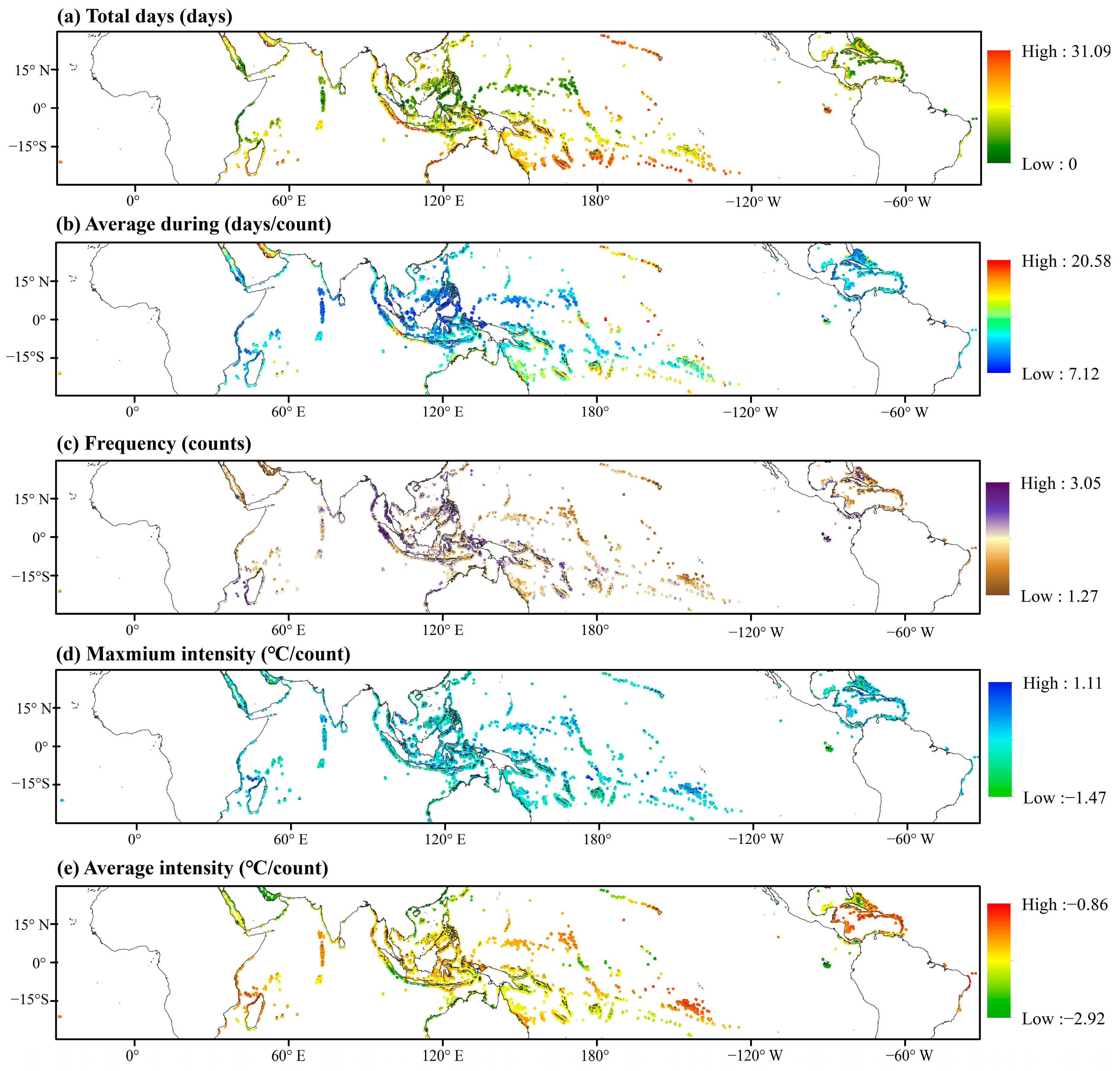




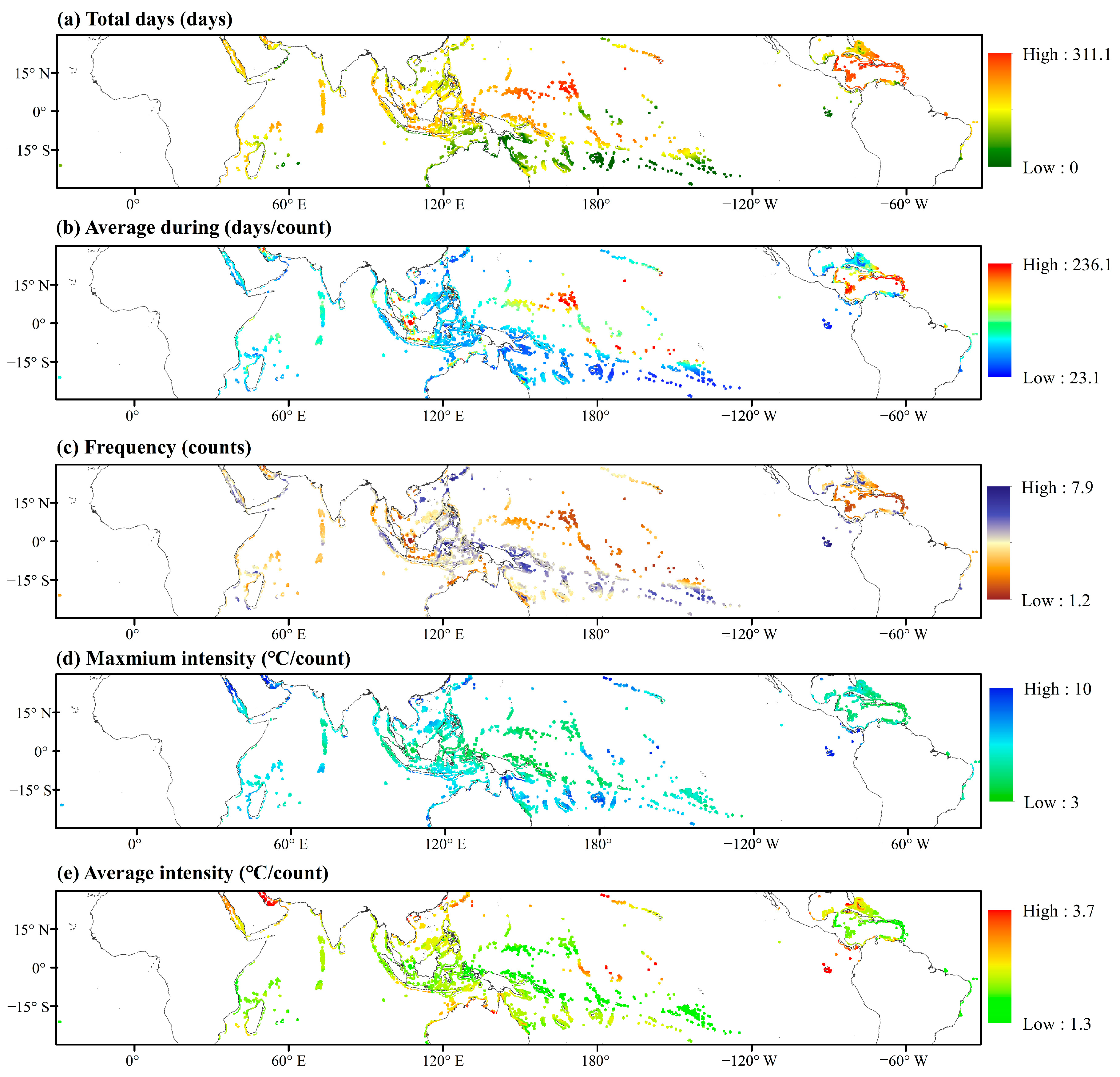






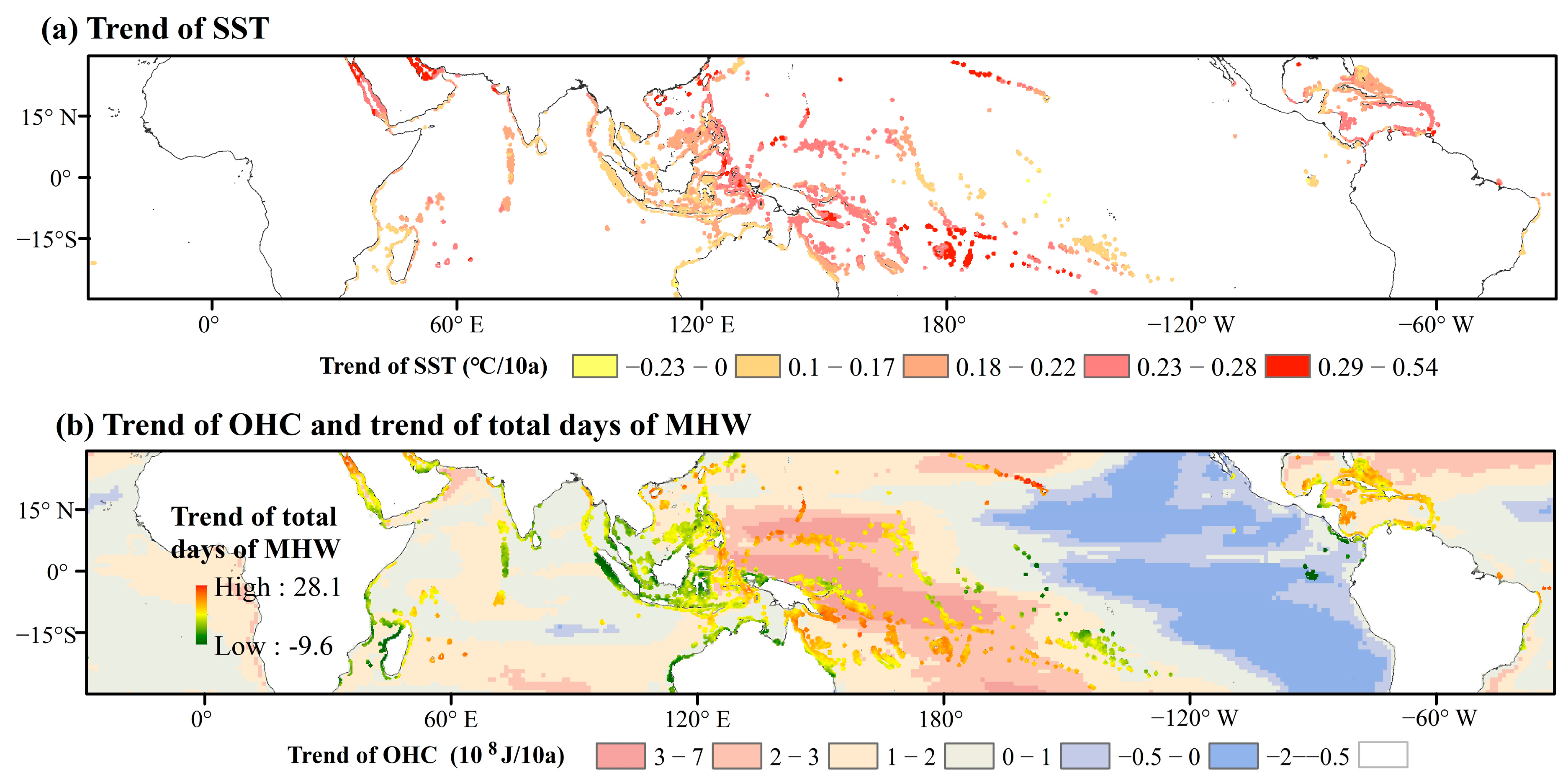
| Definition | Formula | Unit | |
|---|---|---|---|
| Equation (1) | Yearly total count of MHW/MCS events | counts | |
| Equation (2) | Yearly total days of MHW/MCS events | days | |
| Equation (3) | Yearly average duration of all MHWs/MCSs | days/counts | |
| Equation (4) | Yearly average intensity of SST anomalies during all MHWs/MCSs | °C/counts | |
| Equation (5) | Yearly maximum intensity of SST anomalies during all MHWs/MCSs | °C/counts |
Disclaimer/Publisher’s Note: The statements, opinions and data contained in all publications are solely those of the individual author(s) and contributor(s) and not of MDPI and/or the editor(s). MDPI and/or the editor(s) disclaim responsibility for any injury to people or property resulting from any ideas, methods, instructions or products referred to in the content. |
© 2025 by the authors. Licensee MDPI, Basel, Switzerland. This article is an open access article distributed under the terms and conditions of the Creative Commons Attribution (CC BY) license (https://creativecommons.org/licenses/by/4.0/).
Share and Cite
Jiang, H.; Ren, T.; Huang, R.; Yu, K. Marine Heatwaves and Cold Spells in Global Coral Reef Regions (1982–2070): Characteristics, Drivers, and Impacts. Remote Sens. 2025, 17, 2881. https://doi.org/10.3390/rs17162881
Jiang H, Ren T, Huang R, Yu K. Marine Heatwaves and Cold Spells in Global Coral Reef Regions (1982–2070): Characteristics, Drivers, and Impacts. Remote Sensing. 2025; 17(16):2881. https://doi.org/10.3390/rs17162881
Chicago/Turabian StyleJiang, Honglei, Tianfei Ren, Rongyong Huang, and Kefu Yu. 2025. "Marine Heatwaves and Cold Spells in Global Coral Reef Regions (1982–2070): Characteristics, Drivers, and Impacts" Remote Sensing 17, no. 16: 2881. https://doi.org/10.3390/rs17162881
APA StyleJiang, H., Ren, T., Huang, R., & Yu, K. (2025). Marine Heatwaves and Cold Spells in Global Coral Reef Regions (1982–2070): Characteristics, Drivers, and Impacts. Remote Sensing, 17(16), 2881. https://doi.org/10.3390/rs17162881







